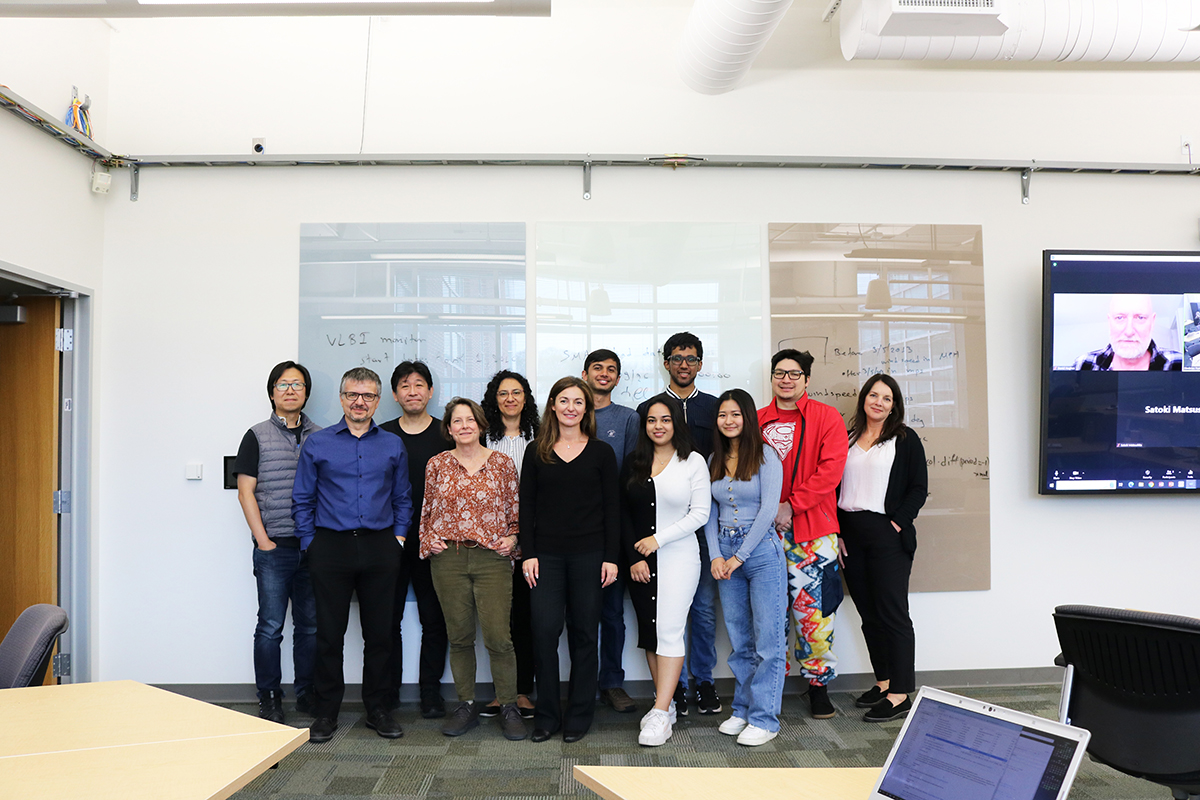The Event Horizon Telescope (EHT) is basically an Earth-sized telescope. Eleven radio telescopes in eight different locations around the world simultaneously coordinate their movements to zero in on black holes, quasars, and other celestial phenomena. But that’s only if the weather cooperates in those locations.
Two of the EHT’s founding members, Dimitrios Psaltis, professor in the School of Physics; and Feryal Özel, professor and chair of the School of Physics at Georgia Tech, hope to use machine learning to boost the accuracy of weather forecasts for EHT telescope sites.
“In order to take a picture of a black hole, all these telescopes need to observe the same black hole at the same time, and each observation lasts for about 10 hours,” Psaltis said. “In order for this to happen, we need to have optimal weather conditions simultaneously at all sites, from Hawaii to the French Alps, and from Chile and the South Pole to Greenland.”
That’s why Psaltis and Özel, who are also members of Georgia Tech’s Center for Relativistic Astrophysics, recently invited 16 EHT researchers to campus to discuss ideas around machine learning and meteorology. The researchers represented the University of Arizona (including Phani Velicheti, undergraduate research assistant) and the Academia Sinica Institute of Astronomy and Astrophysics in Taiwan. Others joined remotely from the Netherlands, as well as the Smithsonian Astrophysical Observatory in Cambridge, Massachusetts and the National Institute of Astrophysics, Optics and Electronics in Mexico.
The Georgia Tech EHT contingent included graduate students Kaushik Satapathy, Sabeeha Syed, and Tyler Trent; also second-year computer science major Seoyeon Kim, and computer science major and School of Physics software developer Anand Tsogtjargal.
“It was great to host our colleagues at Georgia Tech, as we embark on this new technical challenge,” Özel said. “We’re making rapid progress with our great team and the outstanding computational infrastructure here.”
Psaltis wants to use historical weather data from the past two decades at each telescope site, together with global forecasts, to train machine learning algorithms to “tell us how to use global forecasts to pinpoint the upcoming weather conditions on the tops of the mountains, where the telescopes are.” Current forecasting models are averaged over large swaths that can include other nearby sea-level locations, where the weather can be different than at higher altitudes.
The EHT team only gets to use the telescopes for a handful of nights each year, so getting a lot done quickly and accurately is vital to its goals. “Our ability to use the telescopes efficiently depends on identifying the sweet spot in the weather conditions around the globe,” Psaltis said, adding that bad weather fouled up observations in 2018 that resulted in low quality data.
“We will be able to plan our observations better, make more efficient use of very expensive equipment and telescopes, and obtain higher-quality data to create the best pictures of black holes,” he said.
Building the foundation for EHT
In 2000, Özel and Psaltis published one of the first studies establishing the optical observational structure needed to take a picture of a black hole. The two also developed the first numerical simulations of black hole images in 2006. They also organized the inaugural conference of the EHT collaboration in 2012, with Psaltis serving as its first project scientist and Özel as a member of the EHT’s Science Council and the lead of the team that modeled the observations.
The EHT gave the world its first image of a black hole in 2019 when it trained its telescopes on one of the largest known of these phenomena — M87, located 55 million light years from Earth in the Messier 87 galaxy. Science Magazine named the photo the Breakthrough of the Year for 2019.
Özel would go on to lead the 2022 announcement of the EHT’s second photo, one taken of a supermassive black hole called Sagittarius A* within our own Milky Way galaxy. Soon after, Özel was named School of Physics Chair for Georgia Tech, and she and Psaltis, her research partner and spouse, both moved from Arizona to Atlanta to join the College of Sciences faculty and continue their astrophysics work.
“Indeed, we have a special attachment to the image of our ‘very own’ black hole. First of all, this is the black hole in our galactic neighborhood, and we really wanted to see how it looks,” Psaltis said. “Moreover, this was the black hole that started us all into this (EHT) endeavor. However, because we had to look through the entire galaxy in order to take the picture, we had to work extra hard to remove the effects of all the gas and dust that was in our line of sight. Getting the picture was a culmination of two decades of hard work.”
In an earlier interview, Özel also shared that while a graduate student at Harvard, Sagittarius A* (SgrA* for short) was the celestial phenomenon she “fell in love” with, prompting her to work towards eventually capturing a photo of a black hole.
The future of black hole research with the EHT
Özel and Psaltis are also featured in the 2020 documentary, “Black Holes: At The Edge of What We Know”, as they prepare to capture the first black hole image in 2019, and are shown working behind the scenes with other EHT scientists to analyze data. The documentary is streaming on Netflix and Apple TV. Özel was also recently interviewed on the National Public Radio show Science Friday to discuss a new theory, led by University of Hawai’i at Manoa, about dark energy’s potential origins.
“We still struggle to understand many aspects of black holes and how they fit in with the rest of physics,” Özel said. “This is why we attack them from various angles, both observing them from different types of telescopes and modeling them with different theoretical tools.”
Psaltis adds that EHT researchers collect data every spring on both SgrA* and M87. “In the meantime, with our students, we developed a new machine learning algorithm that exploits the capabilities of the telescopes to their fullest extent and generates black hole images with resolution that match those of the telescope specifications,” he said. “In 2023, we expect to share for the first time these images with unprecedented resolution, showing details that were previously hard to discern.”
For More Information Contact
Writer: Renay San Miguel
Communications Officer II/Science Writer
College of Sciences
404-894-5209
Editor: Jess Hunt-Ralston
Communications Director
College of Sciences







